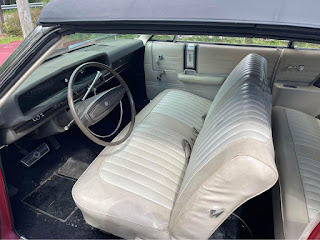Thursday, October 27, 2022
1968 Ford Galaxie 500 Convertible - Not My Father's Ford Ranch Wagon
Monday, October 24, 2022
1993 Oldsmobile Cutlass Supreme SL - Bargain of a Lifetime
Saturday, October 22, 2022
1973 Mercury Comet GT - I Could Have Been a Contender
Wednesday, October 19, 2022
1973 Oldsmobile Cutlass S - Stuff of Legend
Friday, October 14, 2022
1983 Oldsmobile Toronado - Flipping Cars
I toy around with the idea of making extra money "flipping" old cars. Then I think better of it even when something like this 1983 Oldsmobile Toronado pops up on my Facebook Marketplace feed that appears to be pretty clean. Asking price is all of $1,500 too and there's just 48,000 miles on its thirty-nine-year-old analog ticker too. You'd think this the perfect muse for me to flip, right? The poster of the ad claims it needs brake work, but I know better to than to think that's the only thing this will need.
Turns out the front brake lines are rusted through making the car undrivable. The rears still work, but rear brakes are more or less "back-ups" to the front brakes; the majority of a cars braking done by the fronts. Brake lines aren't something that you can buy at Autozone, NAPA or O'Reilly Autoparts either. They have to be custom bent, and the ends need to be properly "fit"; not something I ever want to try again. Trust me. Been there done that. Pull-A-Part yards usually won't let you glom brake lines either. Same with fuel lines. Not that I'd find one of these there anyway.
Conveniently or not so conveniently, this car is in the same town my office is in. That's great. But my office is one-hundred-miles from where I live so this would need to be towed. Although I have up to two-hundred-miles per year towing included with my A.A.A. membership, this could get expensive for me in time and energy spent. Not to mention money.
This generation of Oldsmobile Toronado is the kissin' cousin to the 1982 Buick Riviera I had when I first met my wife. That car, that my wife to this day still refers to as that "Old Man's Car", was the worst daily-driver I've ever had. I say, "daily driver" because my beloved 1977 Chevrolet Corvette is without question the worst car I've ever had at least in terms of reliability but it's not a "daily". At the end of the day, all things being equal and aside, reliability is the most important thing about any vehicle. Will it get you from point A to point B without any drama?
This Toronado and my Riviera share much with the creme-de-la-creme of the class of 1979 General Motors "E-bodies", the Cadillac Eldorado. And of the three of them, on my short list of preference, the Olds Toronado is third behind the Riviera. A distant third I might add. Aesthetically. The cars are all but the same in terms of driving dynamics.
They all share one of the most underappreciated pieces of General Motors engineering prowess of the 1960's, yes, the 1960's, what was referred to as the "Unified Powerplant Package" or "U.P.P.".
The U.P.P. essentially combined the engine, transmission and differential into one compact "package" that laid in front of the firewall. Yes. These cars are front-wheel-drive. GM came out with the U.P.P. on the original Toronado in 1966, the Cadillac Eldorado got the same system, save for using a Cadillac V-8 and not an Olds engine, in 1967. Although starting in 1966 Buick used the same chassis and shell on their Riviera that Oldsmobile used on the Toronado and Cadillac on the Eldorado, they were allowed to eschew the U.P.P. for the at the time more conventional front engine, rear-wheel-drive layout. Ah, the days of real GM divisional autonomy.
Buick eventually used the U.P.P. on the 1979 Riviera which, again, shared much with the also new for 1979 Oldsmobile Toronado and Cadillac Eldorado.
Oddly enough, the only other General Motors application of the U.P.P. was on their front-wheel-drive, fiberglass and aluminum bodied motorhome they sold through GMC from 1973 through 1978.
Thanks to the U.P.P. my Riviera was remarkably spacious for a car that was much smaller in length than the car it replaced, my 1975 Chrysler Cordoba. That's about the only good thing I can say about that bomb that plagued me and my bank account for just under two-years years ago.
Why GM didn't use the remarkably space efficient U.P.P. on intermediate or compact cars is a question us mere mortals will never get an answer to.
I've thought better than to pursue this car which is little more these days than a cheap relic of a bygone luxury car era; the way things used to be so to speak. With its oh-so-limited niche market "appeal", I wouldn't want to be stuck unable to unload it and being so ambivalent towards it, I most certainly wouldn't want to keep it. Regardless of what shape it's in. I mean, seriously, who the hell wants a 1983 Oldsmobile Toronado anyway?




















































